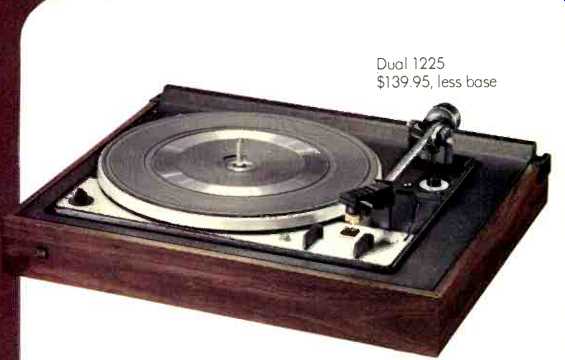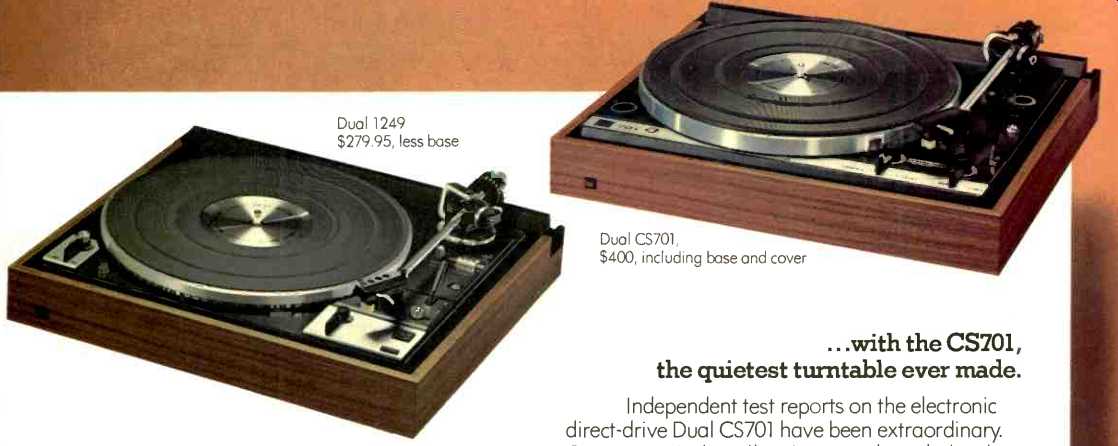Now you can have Dual precision any way you like.
Every Dual, from the 1225 to the CS701, is designed to fulfill one basic concept: to provide more precision than you are ever likely to need.

Perhaps this is why more component owners-audio experts, hifi editors, record reviewers and readers of the music/equipment magazines-own Duals than any other turntable.
These serious music lovers, whose investment in records typically exceeds their investment in equipment, prefer Dual for only one reason.
Quality.
Until recently, Dual quality has been available only with fully automatic turntables with both single-play and multi-play facility. Now the choice is much broader. Of the seven Dual models, three are single-play only. Two of these are fully automatic; one is semi-automatic. Dual turntables also use all three types of drive systems: belt, rim and direct.

The way a tonearm is moved to and from the record is not critical. Nor is the type of drive system. What is critical is how faithfully the tonearm permits the stylus to follow the contours of the groove and how accurately and quietly the platter rotates.
If precision performance and reliability are of primary importance to you--as they should be--you'll find them in every Dual.
---Dual 1225 $139.95, less base
... with the 1225, the lowest priced Dual ... all the turntable you may ever need.
The Dual 1225 is a perfect example of Dual's basic concept: to build every Dual turntable with more precision than you are ever likely to need.
The 1225's vernier adjustable low-mass counterbalanced tonearm can track flawlessly at as low as one gram. Stylus pressure is applied exactly as in every Dual, around the vertical pivot and perpendicular to the groove, maintaining perfect balance in all planes. Anti-skating force is also applied exactly as in every Dual, with separate calibrations for conical, elliptical and CD-4 styli.
Other features the 1225 shares with all other Duals include pitch control variable over a 6% range (one semitone) and cue-control viscous-damped in both directions to prevent bounce. The powerful hi-torque motor maintains speed within 0.1% even when line voltage varies as much as 20%. The hefty 3% pound, 10%" diameter platter provides effective flywheel action to minimize the audible effect of any possible speed variation.
There are two other models in this series, each with additional refinements. The 1226, priced at $169.95, has a one-piece, die-cast platter and a single-play spindle that rotates with the record. The 1228, priced at $199.95, has-in addition to these-a tonearm mounted in a four-point gimbal suspension, synchronous motor, built-in illuminated strobe and adjustable stylus angle to provide perfect vertical tracking in both single and multi play.
... with the new Dual 1249, which will give you more reasons than ever to own a Dual.
The new 1249, successor to the 12290, provides every feature, innovation and refinement of that highly-acclaimed model, plus some new ones. The 8%" tubular tonearm pivots in a newly designed four-point gyroscopic gimbal, suspended within a rigid frame. In single play, the tonearm parallels the record to provide perfect tracking; in multi play, the Mode Selector lifts the entire tonearm to parallel the center of the stack.
The tonearm can be set on the record manually or by using the viscous-damped cue-control or by simply pressing the automatic switch. In addition to single play and multiple play there is also the option of continuous repeat.
The dynamically-balanced cast platter and flywheel are driven by an 8-pole synchronous motor via a precision-ground belt. Pitch is variable over a 6% range and can be set to exact speed by means of an illuminated strobe, read directly off the rim of the platter.
A similar model, the 601, is available at lower cost ($249.95), without multi-play facility. A third Dual in this series, the 510 ($199.95) has a semi-automatic tonearm with a mechanical sensor that indicates when the tonearm is positioned precisely over the lead-in groove of a 12" or 7" record. At the end of play, the tonearm is automatically lifted by the cue-control and the motor shuts off.
... with the CS701, the quietest turntable ever made.
Independent test reports on the electronic direct-drive Dual CS701 have been extraordinary.
One reason is that all reviewers acknowledge the CS701's performance to be superior to the measuring capabilities of test instruments. For example: Hirsch-Houck Labs in Stereo Review found the wow level of the CS701 "Essentially at the residual level of our test record-about 0.03 per cent" So did Popular Electronics. The Feldman Lab Report in FM Guide was able to detect "no flutter whatsoever." Stereo & HiFi Times said "arm friction was lower than my capability to measure reliably." It takes very advanced engineering to achieve this level of performance. For example: the motor's unique double field coil produces a perfectly consistent rotating field with no magnetic flux irregularities. Another example: two specially tuned mechanical anti-resonance filters located within the tonearm counterbalance absorb resonant energy that would otherwise transmit acoustical feedback to the stylus. The result: cleaner and smoother frequency response.
The reviewers also reached unequivocal conclusions about the CS701 performance. Note the absence of such qualifiers as "one of the" or "among the" For example: High Fidelity said: "..The Dual 701 has placed itself in the select group of products against which we must measure the performance of others" And the highly conservative English publication, HiFi News & Record Review: "The experience of listening to records of the highest quality on this turntable is not likely to be forgotten...you will never again be satisfied with anything less perfect"
(Source: Audio magazine, Oct. 1975 )
Also see:
Dual 701 turntable (Aug. 1975)
Dual turntables (ad, May 1975)
= = = =